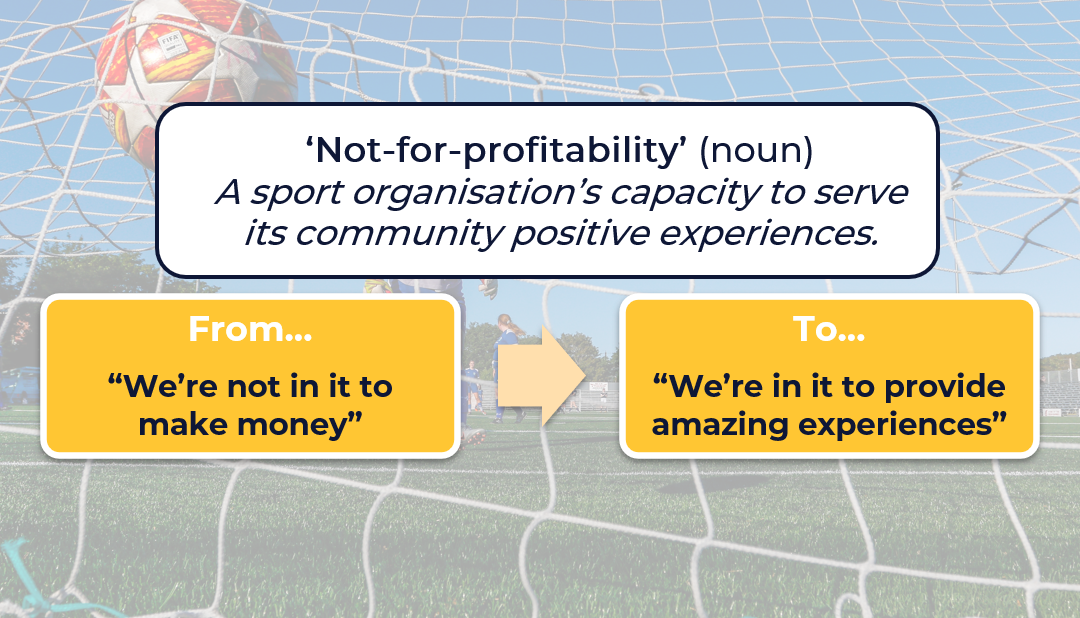Chasing ‘Not-For-Profitability’ in Community Sport
When I present our 9 Ps of Effective Sport Development to sports clubs and reach the 7th P - profitability - I'm often met with raised eyebrows from volunteers and quotes like:
“We're not here to make money"
“We just charge court hire and umpire fees”
"Other sports in the area charge less - we’re just trying to keep up"
It comes from a good place: wanting to maximise access to sport by minimising costs. And strictly speaking, these clubs should not be profitable; I’m not advocating for local sports clubs to trade on the ASX or Dow Jones. The problem is that this philosophy often leads clubs to deliver experiences on the smell of an oily rag, resulting in:
Average program quality
A plateau or decline in participation, and
Burned-out volunteers.
‘Cheap and cheerful’ is not always cheerful
A common way for community sport organisations to develop their break-even pricing is to charge only for the essential costs of participation, for example:
Player registration fee = Court and equipment hire + player affiliation fees + umpire fees
In the business world, this is called a "race to the bottom". In a race to the bottom, we compromise on quality and experience to achieve the cheapest pricing. For a sports club, this means budgeting to provide a basic experience to our communities, rather than a memorable one. And in a post-pandemic world where families are more selective of how they spend their time, there is far less room for “basic” moving forward.
The key principle in this approach is that consumers don’t assess a sports program based on cost, they assess it based on value. Cost is objective, value is subjective - a feeling.
We teach clubs that it’s not about being highly profitable, but rather about being highly ‘not-for-profitable’.
Becoming 'not-for-profitable'
We define not-for-profitability as 'an organisation's capacity to deliver positive impact and serve its community'.
A not-for-profitable club may not offer the cheapest sporting program in the community, but it offers highly satisfied experiences whilst retaining accessible pricing. Rather than avoiding extra earnings wherever possible, not-for-profitability is about viewing earnings as a re-investment opportunity into the experiences of your members.
The common traits we see in highly ‘not-for-profitable’ organisations are things like:
Achieving gradual, consistent participation growth whilst also maintaining member satisfaction ratings above 8 out of 10.
Increased revenue is matched dollar-for-dollar by increased expenditure in staff and projects that impact members positively.
‘More than just sport’ - the organisation sees its role and impact as more than the simple transaction of sport delivery.
Program budgets are based on providing a high quality experience relative to the community’s expectations.
The art for the sport developer is identifying areas where you can improve customer satisfaction by 20%, through only a 5% increase in expenditure.
3 ways to increase your organisation’s not-for-profitability
Reviewing pricing models
For a small increase in participant fees that most parents still consider a bargain, we often find that clubs can and fund a range of experience-improving, ‘wow’-inducing activities such as:
Modified equipment (portable goals and rings)
Additional staff
Rewarding coaches and volunteers
Social activities
Food and drink
Elite player visits
Come and Try Days / themed days
Club merchandise
Note: An increase in fees doesn’t need to be applied across your entire membership. For more info on tiered product offers, read our blog on Applying Good-Better-Best Pricing in Community Sport.
Fundraising & Sponsorship
The Australian Sport Foundation provides a fantastic platform for Australian sporting clubs to raise tax-deductible donations towards their programs and projects. As we publish this it is one week until “tax-time”, so your club could become a perfect last-minute philanthropic opportunity for businesses and individuals.
Coach Education
Let’s say you have a coach who can deliver a positive experience to 10 eight-year olds, but struggles to keep a larger group (20 eight-year olds) or younger participants (10 five-year olds) engaged. If you can up-skill that coach’s ability to manage more kids in a class without detracting from each child’s experience, you have just become more efficient and therefore, not-for-profitable.
Questions to Reflect…
How 'not-for-profitable' is your club/association/league?
How strong is your engine to deliver high-quality experiences to your members?
Where could you enhance your member’s experience by 20%, by increasing expenditure by 5%?
For support
Contact darren@forwardpivot.com.au if you would like to discuss ways your organisation can become more ‘not-for-profitable’ including:
Fundraising and sponsorship strategies
Creating valuable programs whilst maintaining accessible pricing.
Member ‘willingness to pay’ research
Coach education on engaging large groups of 5-10 year olds

